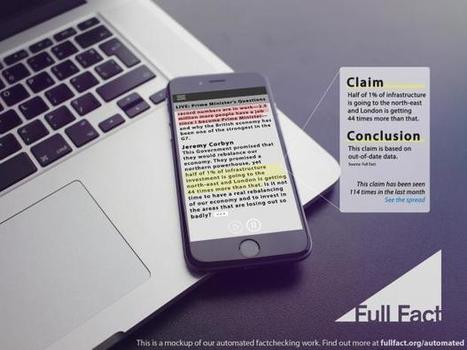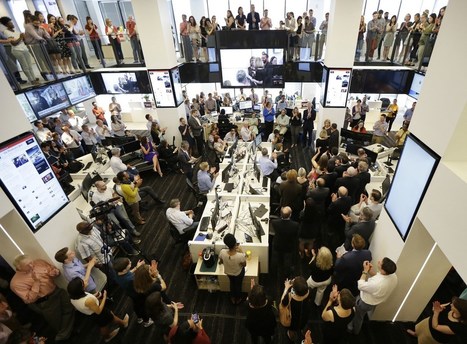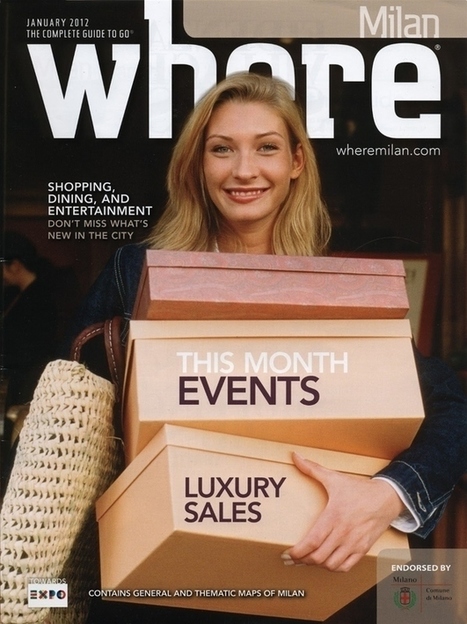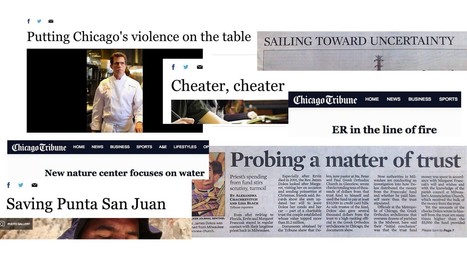 Your new post is loading...
 Your new post is loading...
Each year, I keep a running list of exceptional nonfiction that I encounter as I publish The Best of Journalism, an email newsletter that I curate weekly for its subscribers. This is my annual attempt to bring roughly 100 of those stories that stood the test of time to a wider audience. I could not read or note every worthy article published in the past few years, and I haven't included any paywalled articles or anything published at The Atlantic. But everything that follows is worthy of wider attention and engagement. I hope it provides fodder for reflection and inspiration for future writing. My thanks to all of the publishers, editors and, writers who made these gems possible.
Google has agreed to fund a project to develop automated fact checking tools amid anger over the prevalent of fake news websites during the US presidential election.
UK fact checking organisation, FullFact, has announced it has been awarded €50,000 (£43,000) by the tech giant’s Digital News Initiative to build the first “fully automated end-to-end fact checking system”.
In a statement, FullFact explained that the system will have two main features.
One will inform readers if something reported as fact has already been proven inaccurate.
The other mode will fact check claims automatically using Natural Language Processing and statistical analysis in real-time – something FullFact said has never been done before – by highlighting the text and having a factbox appear when the user hovers over it....
In August, Washington Post Managing Editor Cameron Barr and his fellow senior editors decided to do something about a problem that had been niggling at them for some time:
Articles were becoming too long, often for no good reason.
"We were seeing too many pieces that were in the mid-range of their ambition and their success — coming in at 60, 70 inches of copy," Barr said. "We were seeing the same thing in a number of blogs, where pieces were just too long, and we felt as though editors were not applying the necessary discipline and rigor in how these pieces were being handled on the desk."
The solution? A newsroom-wide initiative to cut down on editorial flab, Barr said. Since the middle of August, he's asked Post's department heads to take responsibility for articles longer than 1,500 words online or 50 inches in print. Bylines, captions, headlines and subheadings don't count....
How not to edit a publication.
Luke Lewis shares 28 great editing and layout fumbles.
Since launching in private beta last year, Medium has been building up its platform, which aims to offer a simple but 'beautiful' reading and writing experienceIt was one year ago this week when the online publishing world was abuzz with the news that two of Twitter's founders had launched a new platform called Medium, in private beta.In the early days only a select group of people were allowed behind the scenes to contribute content to Medium.
Some details on the platform were made public via an announcement post from Ev Williams, in which he described Medium as "a new place on the Internet where people share ideas and stories that are longer than 140 characters and not just for friends".In the past year the group of people invited to write has grown, and we are told it "should be a short wait from now" when the platform will be available for all to use.
The main aim of Medium is to be "the best place to read and write about things that matter", and this emphasis on both the writing and reading experience has been reflected in its approach over the past 12 months....
In April 2011, Kelley Benham gave birth four months early. Her daughter Juniper’s birth was supposed to be a joyous occasion. Instead, it was marked by physical and emotional pain, shock, and uncertainty about whether the micro preemie, who weighed just 1 pound 4 ounces, would survive. Benham and her husband, journalist Tom French, were faced with a pivotal question: Fight for their daughter’s life or let her go? In a recent three-part series in Poynter’s Tampa Bay Times, Benham wrote about how she and French confronted this question and how the answer they sought has changed their lives. “A story is a promise,” French said to her as they read to Juniper. “It’s a promise that the end is worth waiting for.”...
[This post features a really good list of smartphone apps for photos, photo editing, video, audio, recording calls, writing and social network tools. Useful for PR, journalists or anyone producing content and stories. ~ Jeff]
National Magazine Award judges have a tough job this year as they choose a winner in the features category. There’s the sobering story about a corporate attorney’s mysterious death in Guatemala; the bizarre tale of a pair of young international arms dealers; the moving account of two dozen strangers braving a massive tornado; a fable-like piece about a man who rode out the Japanese tsunami on the roof of his house; and a high-larious (pardon us) story about a darker side of Disney World. The American Society of Magazine Editors will announce the winner on May 3, but until then here’s a sampling from those five fine finalists, written by some of the top names in narrative:... [Great writing and great reading - JD]
|
Online, your product is unbundled. You get 10 words. Or 8. Or maybe 13, like I used above, to market your work. Digital success is like selling a newspaper story by story rather than day by day or week by week. And in selling that day’s paper, by subscription or newsstand, there’s just less urgency to make the headline awesome on that 150-word story buried at the bottom of page 11. Sections and geographic centers all are comfortable assumptions you can’t make in digital headlines. You must have a certain sense of desperation in writing web headlines, like those eight words are the difference between that column’s or blog’s life or death. Mostly, because it is. You aren’t owed readership. Your headline helps earn it — along with a handful of other factors like author and brand.
So any strategy involving growing and sustaining digital audience must incorporate excellence in headline writing. Must.
A few points to clarify here as we begin. I’ll be discussing writing for readers here, not for search engine optimization. That will be a consideration at times, but mostly we’re talking about people creating headlines for people....
In 1977, according to the AP style guide I still occasionally refer to, using the acronym “TV” as a noun when writing about television was not advised.
“Acceptable as an adjective or in such constructions as cable TV [italics theirs]. But do not normally use as a noun unless part of a quotation,” counsels the item on “TV” in the 1977 edition of the AP Stylebook -- formerly titled “The Associated Press Stylebook and Libel Manual.”
Today we use “TV” and “television” more or less interchangeably as nouns, although the former is probably used more now than the latter. One thing the 1977 Stylebook reveals, however, is that “media” -- whether electronic or otherwise -- was not nearly the obsession for news organizations that it is today.
Part of the reason was that the world at large was not nearly as obsessed with media and technology -- and the companies responsible for them -- as we are now. There was so much less of it then too, obviously....
If you're in the market for a free journalism education, hundreds of training materials are now at your disposal.If you're in the market for a free journalism education, hundreds of training materials are now at your disposal.
The BBC's College of Journalism made a slew of videos and guides - initially created to train its own journalists - available to reporters worldwide for free.You can watch videos and tutorials made by BBC journalists in the field on journalists' safety, social media, multimedia techniques, as well as subject and writing style guides galore. Check out the whole library here....
Five Steps to Multimedia Storytelling Is a valuable, free course offered through Poynter News University.
TITLE:Five Steps to Multimedia StorytellingTYPE:Self-Directed Course T IME ESTIMATE:This course takes about one to two hours to complete.
ABOUT SELF-DIRECTED COURSES
In a self-directed course, you can start and stop whenever you like, progressing entirely at your own pace and going back as many times as you want to review the material.
Want to spread your wings beyond print reporting, but don’t know where to start? In this course, you’ll learn the basic steps of telling your story with multimedia. You’ll discover ways to map out your story before you head out to do your reporting. And you’ll learn when to use such tools as audio, video and graphics.
WHAT WILL I LEARN? - Upon completing this course, you will be able to:Identify the elements in a multimedia story. - Understand which stories are more suitable for multimedia - Sketch a concept for a story - Identify tools needed to gather content in the field...
You'll never believe Peter Koechley's OUTRAGEOUS headline writing tips. For most of us in the online journalism business, writing headlines basically amounts to guesswork. Will people click on this? Are there enough nouns in here for Google to find it? Does this line break look weird? Should I use a question mark? An exclamation point? For Upworthy, it’s more akin to a science — and not one of those mushy sciences like anthropology or psychology, either. We’re talking straight-up particle physics. For every article they publish, its writers come up with 25 headline options. They then A/B test the four most promising before settling on a winner. The result: In just 11 months, with a smallish staff and not much original content, Upworthy has built a sizable audience (8.7 million monthly unique visitors as of last November) for its socially progressive message, plus a Facebook following of more than 1 million fans....
...So, all in all, it’s more than instructive to check in on longform newspaper writing, and the start of a new year isn’t a bad time to do it. And it’s pretty to shocking to see what’s become of the time-honored form since the newspaper industry’s great unraveling started a decade ago. The Los Angeles Times, for instance, published 256 stories longer than 2,000 words last year, compared to 1,776 in 2003—a drop of 86 percent, according to searches of the Factiva database. The Washington Post published 1,378 stories over 2,000 words last year, about half as many as 2003 when it published 2,755. The Wall Street Journal, which pioneered the longform narrative in American newspapers, published 35 percent fewer stories over 2,000 words last year from a decade ago, 468 from 721. When it comes to stories longer than 3,000 words, the three papers showed even sharper declines. The WSJ’s total is down 70 percent to 25 stories, from 87 a decade ago, and the LA Times down fully 90 percent to 34 from 368....
My love affair with narrative nonfiction was in its early stages when I first read Robert Kurson’s “Into the Light,” in the June 2005 edition of Esquire. I was mostly clueless about the art of plotting as a way to transport and transform the reader, but when Kurson’s story pulled my emotions in opposite directions, I began to understand the particular power of building tension by changing course. Reading “Into the Light” is like having a deep and tormenting debate with a friend over drinks about the meaning of life and the cost of change.... [Storytelling so good! JD]
|
 Your new post is loading...
Your new post is loading...
 Your new post is loading...
Your new post is loading...





























This list honors the craft of journalism - fantastic nonfiction from 2016 is still worth discovering and pondering today. Highly recommended! 10/10